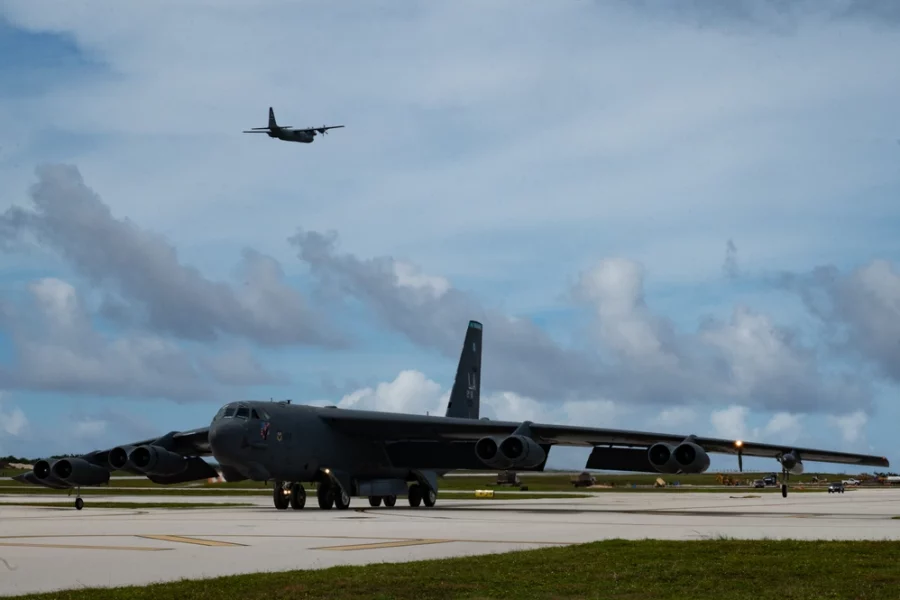Two B-52 bombers are taking part in a Bomber Task Force deployment from Andersen Air Force Base, Guam, for an unspecified period after participating in Balikatan 2024 multiservice, multinational exercise centered on the Philippines, the Pentagon said.
It is the fourth B-52 BTF dispatched to the Indo-Pacific in as many months. There were B-52 BTFs to Guam in February and March, and another B-52 BTF to Diego Garcia in the Indian Ocean.
The B-52s launched April 25 from Barksdale Air Force Base, La., and likely played a role in the exercise involving anti-shipping or minelaying, but neither Global Strike Command nor Pacific Air Forces would comment on their specific activities.
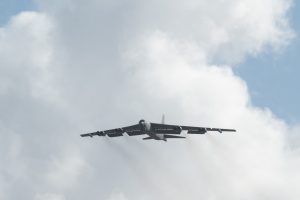
A U.S. Air Force B-52H Stratofortress, assigned to Barksdale Air Force Base, Louisiana, assumes a holding pattern before landing at Andersen Air Force Base, Guam, after completing a Bomber Task Force mission in support of Exercise Balikatan 24, hosted in the Philippines, April 29, 2024. Bomber missions provide opportunities to train and work with Allies and partners in joint and coalition operations and exercises. BK 24 is an annual exercise between the Armed Forces of the Philippines and the U.S. military designed to strengthen bilateral interoperability, capabilities, trust, and cooperation built over decades of shared experiences. (U.S. Air Force photo by Tech. Sgt. Eric Summers Jr.)
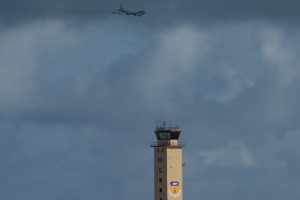
A U.S. Air Force B-52H Stratofortress, assigned to Barksdale Air Force Base, Louisiana, assumes a holding pattern before landing at Andersen Air Force Base, Guam, after completing a Bomber Task Force mission in support of Exercise Balikatan 24, hosted in the Philippines, April 29, 2024. Bomber missions provide opportunities to train and work with Allies and partners in joint and coalition operations and exercises. BK 24 is an annual exercise between the Armed Forces of the Philippines and the U.S. military designed to strengthen bilateral interoperability, capabilities, trust, and cooperation built over decades of shared experiences. (U.S. Air Force photo by Tech. Sgt. Eric Summers Jr.)
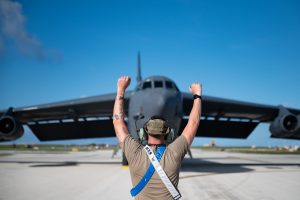
U.S. Air Force Senior Airman Jacob Kellet, a dedicated crew chief with 2nd Aircraft Maintenance Squadron, signals for a B-52H Stratofortress, assigned to Barksdale Air Force Base, Louisiana, to stop on Andersen Air Force Base, Guam, after completing a Bomber Task Force mission in support of Balikatan 24, hosted in the Philippines, April 29, 2024. Bomber missions provide opportunities to train and work with Allies and partners in joint and coalition operations and exercises. BK 24 is an annual exercise between the Armed Forces of the Philippines and the U.S. military designed to strengthen bilateral interoperability, capabilities, trust, and cooperation built over decades of shared experiences. (U.S. Air Force photo by Tech. Sgt. Eric Summers Jr.)
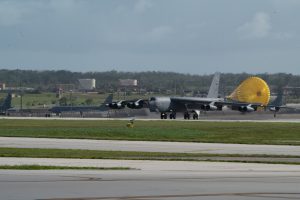
A U.S. Air Force B-52H Stratofortress, assigned to Barksdale Air Force Base, Louisiana, arrives at Andersen Air Force Base, Guam, after completing a Bomber Task Force mission in support of Exercise Balikatan 24, hosted in the Philippines, April 29, 2024. Bomber missions provide opportunities to train and work with Allies and partners in joint and coalition operations and exercises. BK 24 is an annual exercise between the Armed Forces of the Philippines and the U.S. military designed to strengthen bilateral interoperability, capabilities, trust, and cooperation built over decades of shared experiences. (U.S. Air Force photo by Tech. Sgt. Eric Summers Jr.)
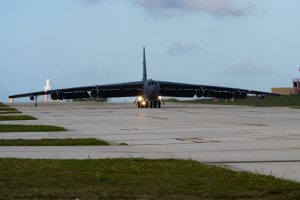
A U.S. Air Force B-52H Stratofortress, assigned to Barksdale Air Force Base, Louisiana, arrives at Andersen Air Force Base, Guam, after completing a Bomber Task Force mission in support of Exercise Balikatan 24, hosted in the Philippines, April 29, 2024. Bomber missions provide opportunities to train and work with Allies and partners in joint and coalition operations and exercises. BK 24 is an annual exercise between the Armed Forces of the Philippines and the U.S. military designed to strengthen bilateral interoperability, capabilities, trust, and cooperation built over decades of shared experiences. (U.S. Air Force photo by Tech. Sgt. Eric Summers Jr.)
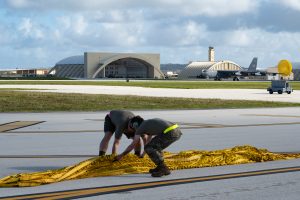
U.S. Airmen assigned to the 2nd Bomb Wing remove a drogue parachute from the runway following the landing of a B-52H Stratofortress deployed from Barksdale Air Force Base, Louisiana, at Andersen Air Force Base, Guam. The B-52s are part of a Bomber Task Force deployment in support of Exercise Balikatan 24, April 29, 2024. Bomber missions provide opportunities to train and work with Allies and partners in joint and coalition operations and exercises. BK 24 is an annual exercise between the Armed Forces of the Philippines and the U.S. military designed to strengthen bilateral interoperability, capabilities, trust, and cooperation built over decades of shared experiences. (U.S. Air Force photo by Tech. Sgt. Eric Summers Jr.)
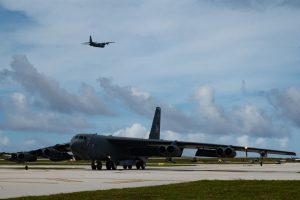
A U.S. Air Force B-52H Stratofortress, assigned to Barksdale Air Force Base Louisiana, arrives for a Bomber Task Force deployment at Andersen Air Force Base, Guam, April 25, 2024. Bomber missions provide opportunities to train and work with our Allies and partners in joint and coalition operations and exercises. The U.S. looks for every opportunity to train alongside Allies and partners to demonstrate interoperability and bolster the collective ability to support a free and open Indo-Pacific. (U.S. Air Force photo by Tech. Sgt. Eric Summers Jr.)
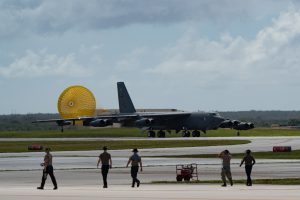
U.S. Air Force Airmen from the 2nd Bomb Wing, Barksdale Air Force Base, Louisiana, prepare to receive a B-52H Stratofortress after it lands at Andersen Air Force Base, Guam, April 25, 2024. Bomber missions provide opportunities to train and work with our Allies and partners in joint and coalition operations and exercises. The U.S. looks for every opportunity to train alongside Allies and partners to demonstrate interoperability and bolster the collective ability to support a free and open Indo-Pacific. (U.S. Air Force photo by Tech. Sgt. Eric Summers Jr.)
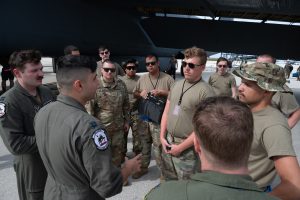
U.S. Air Force Airmen from the 2nd Bomb Wing, Barksdale Air Force Base, Louisiana, debrief after landing at Andersen Air Force Base, Guam, for a Bomber Task Force deployment in support of Balikatan 24. BK 24 is an annual exercise between the Armed Forces of the Philippines and the U.S. military designed to strengthen bilateral interoperability, capabilities, trust, and cooperation built over decades of shared experiences. (U.S. Air Force photo by Tech. Sgt. Eric Summers Jr.)
In the 16-day exercise—still ongoing and some of which was live-fire—an Air Force AC-130 sank a small fishing vessel.
According to U.S. Indo-Pacific Command, the wargame’s objective is to practice operations in the “complex littoral and coastal” regions of the Philippines, to “secure and protect [its] maritime terrain, territorial waters and exclusive economic-zone interests.”
The bombers flew to the vicinity of the Philippines from Barksdale, then recovered at Andersen, where they will be based for much of the BTF, Air Force officials said.
Balikatan—meaning “shoulder-to-shoulder”—is an annual exercise involving the U.S., the Philippines, and various other countries. This installment also saw large numbers of U.S. Marine Corps troops, helicopters and armored vehicles deploy, exercise to oppose a hostile landing, and fire HIMARS and other ground-launched rockets and artillery. This edition saw the largest number of participants yet, with 16,000 troops from both the U.S. and Philippines. Large contingents from the Australian defense forces and French Navy also took part.
The annual wargame is conducted under the aegis of the 1951 Mutual Defense Treaty between the U.S. and Philippines, a bilateral agreement in which each country pledges to come to the aid of the other in the event of an armed attack. Spokespersons for both countries said the exercise was long-planned and not a response to any recent activities by China, which has recently voiced warnings not to encroach on regions of the sea that it claims as its national waters. China commented on the Balikatan exercise itself, calling it “provocative.”
The exercise covers large swaths of the Northern, Western, and Southern regions of Philippine territory.
Balikatan comprises three elements in one: a Command and Control exercise (C2X)—which this year has an elaborate Cyber Defense element—a Field Training Exercise (FTX), and a Humanitarian Civic Assistance (HCA) element.
The B-52s played a role in the FTX, which is a joint, all-domain wargame involving protection of sea lanes of communication, protection of the islands themselves, airborne assaults, and intelligence, surveillance and reconnaissance tasks. There was also an elaborate integrated air and missile defense element to the wargames.
U.S. Indo-Pacific Command said a “Martitime Strike” activity would include “joint and combined fires, combined joint dynamic targeting, and multi-domain effects” including the sinking of an adversary vessel.
The AC-130J that carried out the live-fire strike was from the 127th Special Operations Wing at Cannon Air Force Base, N.M.
The wargames also included MQ-9 Reaper remotely-piloted hunter/killer drones.
Countries invited to participate as observers include Brunei, Canada, France, Germany, Great Britain, India, Indonesia, Japan, Malaysia, New Zealand, Republic of Korea, Singapore, Thailand, and Vietnam.
In the February BTF, the B-52 trained alongside Philippine Air Force fighters. Separately, a B-52 test-fired a hypersonic AGM-183 Air-Launched Rapid Response Weapon (ARRW) in the region in March, also operating from Andersen.
In recent years, BTFs have flown freedom-of-navigation missions over areas of the open sea that China claims as its airspace, resulting in close interceptions by Chinese aircraft.
